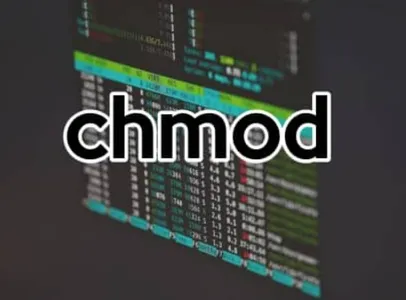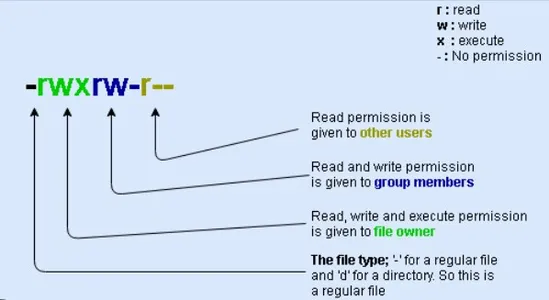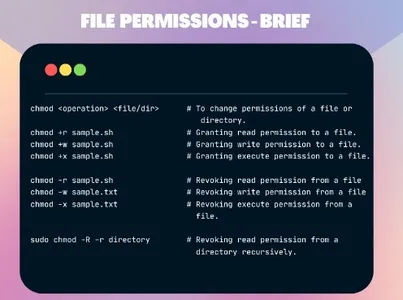Introduction
Delving into the core of Linux, file permissions stand as the bedrock of the system’s security and functionality. Proficiency in manipulating these permissions is essential for those aiming to excel in Linux. The chmod command, an abbreviation for “change mode,” acts as the key tool for modifying access rights to files and directories. In this article, we will unravel the mysteries of the chmod command, equipping you with the knowledge to wield this potent tool confidently and precisely.

Table of contents
Understanding File Permissions
Before delving into file permission manipulation, it’s crucial to comprehend their nature. In Linux, each file and directory boasts three types of permissions:
- Read (r)
- Write (w)
- Execute (x)

These permissions can be configured for three distinct user groups: the owner, the group, and others. The ls -l command exposes these permissions through a 10-character string. The first character denotes the type (file or directory), followed by three sets of rwx symbols representing the permissions for each group.
For instance:
chmod 764 example.txt
Breaking down the permission string:
- The first character ‘7’ signifies the owner’s permissions. In binary, 7 (111) translates to read (r), write (w), and execute (x) permissions.
- The second character ‘6’ signifies the group’s permissions. In binary, 6 (110) indicates read and write permissions but no execute permission.
- The third character ‘4’ signifies permissions for others (users not in the owner or group). In binary, 4 (100) represents only read permission.
In this example, the owner has read, write, and execute permissions; the group has read and write permissions, while others have only read permission on the “example.txt” file.
Also Read: Getting Started with Linux File System
The Basics of the Chmod Command
The chmod command alters file permissions in two ways: symbolic mode or numeric (octal) mode. Symbolic mode uses letters and symbols to represent changes, such as ‘chmod u+x filename’ adding execute permission for the user. Numeric mode, on the other hand, uses three-digit numbers to set permissions for all groups simultaneously.

Example:
chmod 755 filename
Symbolic Mode In-Depth
Symbolic mode provides a more intuitive approach, using letters (u, g, o, a) to specify the user group and symbols (+, -, =) to denote the action (add, remove, set exactly). For instance, ‘chmod g-w filename’ removes write permission from the group.
Numeric Mode Mastery
Numeric mode is concise and often faster for experienced users. Each permission type corresponds to a number: read (4), write (2), and execute (1). These values are summed up to establish the desired permissions for each user group. For example, ‘chmod 644 filename’ sets read and write permissions for the owner and read-only for the group and others.
Also Read: Getting Started with Linux File System
Setting Default Permissions with Umask
The umask command establishes default permissions for newly created files and directories. It subtracts permissions from the system defaults, typically 666 for files and 777 for directories. For instance, a umask of 022 results in new files having 644 permissions.
Advanced Chmod Usage
Moving beyond the basics, chmod can be employed recursively to alter permissions for all files within a directory and its subdirectories using the -R option. Additionally, it’s possible to copy permissions from one file to another using the –reference option, streamlining the process of setting consistent permissions across multiple files.
Best Practice and Common Pitfalls
When using chmod, adhering to best practices is crucial for maintaining system security. Avoid granting execute permissions to files unless necessary and exercise caution when configuring permissions for the ‘others’ group. Common pitfalls include inadvertently removing essential permissions or providing excessive permissions, potentially exposing your system to security risks.
Also Read: AWK Command: Learn How to Use it in Unix/Linux Systems
Conclusion
Mastering the chmod command is a significant milestone for Linux users, granting the ability to control access and modifications to files and directories. By comprehending both symbolic and numeric modes, setting default permissions with umask, and adhering to best practices, you can ensure the security and smooth operation of your Linux system. Always remember, with great power comes great responsibility—use chmod judiciously to safeguard your Linux domain.
Frequently Asked Questions
A. File permissions in Linux define the access rights to files and directories, determining who can read, write, or execute them. They are crucial for system security by controlling user interactions with sensitive data and programs.
A. The chmod command in Linux allows users to change the permissions of files and directories. It provides flexibility in assigning read, write, and execute permissions for the owner, group, and others, ensuring precise control over access.
A. The numeric representation in “chmod 755” is an octal representation of permissions. The first digit (7) corresponds to the owner’s permissions, the second (5) to the group, and the third (5) to others. Each digit is a sum of read (4), write (2), and execute (1) permissions.
A. The ls -l command displays file permissions in a 10-character string. The first character denotes the file type (e.g., file or directory), and the next three sets of rwx symbols represent read, write, and execute permissions for the owner, group, and others, respectively.
Related
- SEO Powered Content & PR Distribution. Get Amplified Today.
- PlatoData.Network Vertical Generative Ai. Empower Yourself. Access Here.
- PlatoAiStream. Web3 Intelligence. Knowledge Amplified. Access Here.
- PlatoESG. Carbon, CleanTech, Energy, Environment, Solar, Waste Management. Access Here.
- PlatoHealth. Biotech and Clinical Trials Intelligence. Access Here.
- Source: https://www.analyticsvidhya.com/blog/2024/01/updating-file-permissions-in-linux-with-chmod/



